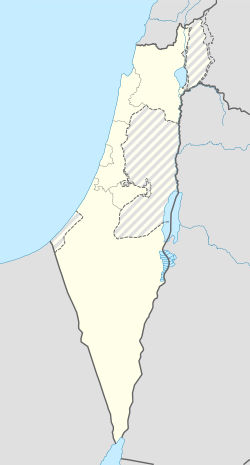 Mosaic of Rehob | |
| Alternative name | Inscription of Tel Rehov |
|---|---|
| Location | Tell el-Farwana (Khirbet Farwana), Israel |
| Region | Beit She'an, Israel |
| Coordinates | 32°27′47″N 35°29′37″E / 32.46306°N 35.49361°E |
| Type | Mosaic |
| Part of | Synagogue |
| Area | 4.30 by 2.75 metres (14.1 ft × 9.0 ft) |
| History | |
| Founded | c. late 3rd century CE[1] |
| Abandoned | 7th century CE |
| Periods | Roman to Byzantine |
| Cultures | Byzantine |
| Site notes | |
| Excavation dates | 1973 |
| Archaeologists | Yaakov Sussmann, Shaul Lieberman, Fanny Vitto |
| Condition | Good (although removed from locale) |
| Ownership | Israel Museum |
| Public access | Yes, both to the museum and to the open field with scarce remains |
| Website | www |
The Mosaic of Reḥob (Hebrew: כתובת רחוב, romanized: k'tovet rechov, also known as the Tel Rehov inscription and the Baraita of the Boundaries), is a late 3rd–6th century CE mosaic discovered in 1973. The mosaic, written in late Mishnaic Hebrew, describes the geography and agricultural rules of the local Jews of the era. It was inlaid in the floor of the foyer or narthex of an ancient synagogue near Tel Rehov,[2][3] 4.5 kilometres (2.8 mi) south of Beit She'an and about 6.5 kilometres (4.0 mi) west of the Jordan River. The mosaic contains the longest written text yet discovered in any Hebrew mosaic in Israel, and also the oldest known Talmudic text.[4]
Unlike other mosaics found in the region, the Reḥob mosaic is unique not for its artistry and ornate patterns but for the text incorporated in it. Scholars say it is one of the most important epigraphical findings in the Holy Land in the last century,[5] and sheds invaluable light on the historical geography of Palestine during the Late Roman and Byzantine periods, as well as on Jewish and non-Jewish ethnographic divisions in Palestine for the same periods.
The mosaic describes the body of Jewish law regulating the use of farm products grown in different regions.[6] In Jewish tradition, certain laws are only applicable within the Land of Israel proper. By delineating the boundaries of the Land of Israel at the time, the mosaic seeks to establish the legal status of the country in its various parts from the time of the Jewish people's return from the Babylonian captivity.[7][a] It describes whether or not local farm products acquired by Jews from various sources are exempt from the laws of Seventh Year produce, and gives guidelines for dealing with demai produce (produce whose tithing status is uncertain).[9]
- ^ Feliks, Yehuda (1986), pp. 454–455 (the actual time-frame of its making is disputed)
- ^ Vitto 1975, p. 119
- ^ The actual archaeological site was located ca. 800 metres (2,600 ft) northwest of Tel Rehov. See Vitto 2015, p. 10, note 2; "Archived copy" (PDF). Archived from the original on 1 August 2019. Retrieved 15 July 2019.
{{cite web}}: CS1 maint: archived copy as title (link) CS1 maint: bot: original URL status unknown (link). - ^ Sussmann 1975, pp. 123, 124. Quote: [p. 123] "The inscription contains twenty-nine long lines, among which are 1807 letters! It is, by far, larger than all the inscriptions discovered until now among mosaic flooring, whether those belonging to ancient synagogues or those belonging to other structures. Thus, for example, it is more than three-times larger than the inscription found at Ein Gedi, which was discovered a few years ago, and which was, until now, the largest one discovered in the country." [...] [p. 124] "This is the first time that we have access to any Talmudic text inscribed close to the time of its inception and in close proximity to the centers of Talmudic formulation in the Land of Israel, a text that was inscribed, presumably, not too far after the redaction of the original Palestinian work, and in a place that is nigh the spiritual center of the Land of Israel during the Talmudic era: viz., Tiberias of the 5th-century (B)CE (sic). The text before us is not dependent upon the textual tradition of handwritten manuscripts, the pathway in which the Palestinian Talmudic literature has reached us; nor was it transferred unto us by way of reed pens (calamus) used by the scribes, copyists and proofreaders of various kinds, and for this reason it is invaluable for offering a critique on the Talmudic text. What is especially important is the clear Palestinian spelling of words, and their original versions of many geographical place-names, two areas that were rife with copyist-errors, and those made by proofreaders."
- ^ Sussmann 1975, p. 123
- ^ Vitto 2015, p. 7; Sussmann 1975, p. 124; et al.
- ^ Ben David 2011, p. 238; Lieberman 1976, p. 55; Levine 2010, p. 13, et al.
- ^ Mishnah (1977), Tractate Shebiith 6:1 (pp. 45–46), which reads: "Three countries are to be distinguished in what concerns the Seventh Year: throughout that part of the Land of Israel which they occupied that came up from Babylon, as far as Chezib, [Seventh Year produce] may not be eaten nor [may the soil be] cultivated; throughout that part which they occupied that came up from Egypt, from Chezib to the River and Amanah, [Seventh Year produce] may be eaten but [the soil] may not be cultivated; while in the country from the River and Amanah and inwards, [Seventh Year produce] may be eaten and [the soil] cultivated" (End Quote).
- ^ Sussmann 1975, p. 124; Feliks 1986, p. 454; Jewish legal inscription from a synagogue Archived 28 March 2019 at the Wayback Machine, Israel Museum, Jerusalem
Cite error: There are <ref group=lower-alpha> tags or {{efn}} templates on this page, but the references will not show without a {{reflist|group=lower-alpha}} template or {{notelist}} template (see the help page).

